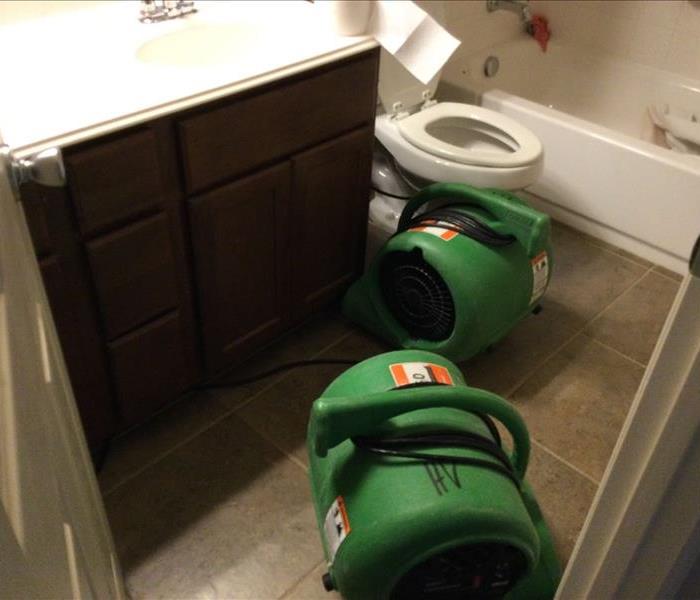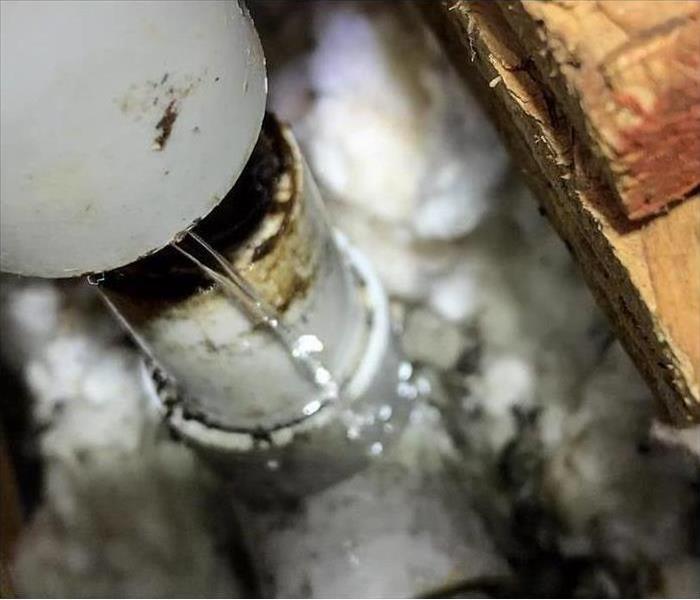Archived Water Damage Blog Posts
Party Ruiner
9/14/2022 (Permalink)
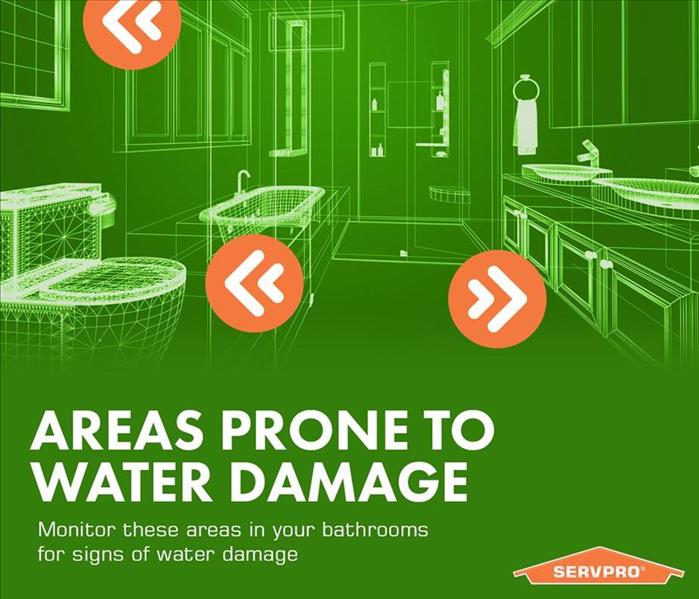 Bathrooms are the leading cause of water damage in homes
Bathrooms are the leading cause of water damage in homes
Know what ruins parties? Water damage from a clogged toilet!
Musty odor, wet, stained, or damaged floors could all be effects of an overflowed toilet.
Most residential water damage situations happen from bathroom issues. That’s why it’s important to check your bathroom regularly to ensure nothing is damaged or leaking. Anticipatory measures could potentially save you hundreds of dollars in the long run. In the event that you did not catch any potential issues in time, DON’T WORRY, SERVPRO can save the day, but maybe not the party.
One recommendation to ensure your bathroom has the best possible chance to make it through a party without any issues is to check the toilet reservoir and visually inspect the components. Over time these components can become compromised and break. It is also a good habit to know exactly where your shut-off valve is located in the event that you would need to shut off the water to mitigate any damage.
If you have found yourself in this situation, don’t hesitate to give SERVPRO of Highland Village a call. We can get things cleaned up and back to “like it never even happened” in no time!
(940)-241-3434
Water damage, lets not make it worse.
7/8/2022 (Permalink)
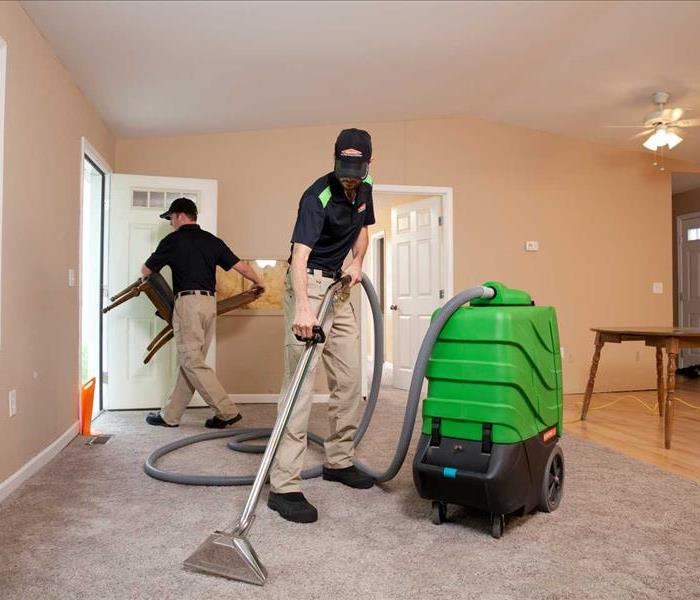 Home water damage trouble
Home water damage trouble
If you are anything like the typical homeowner, when water damage happens in your home, the question may arise, when should I contact some help? How much can I do by myself? Can this wait? All legitimate questions, however, in our professional opinion, seeking professional help is NEVER a bad thing. In fact, in cases where people decide to wait or are unsure what direction to take, it usually ends up being more expensive in the end. Water jobs certainly do NOT get better over time. Whether it’s a leaking AC unit caused by living in Texas, which on most days feels like the surface of the sun, or a dishwasher going rouge, all problems that should not be ignored. At SERVPRO of Highland Village, we offer free and honest estimates for any scenario. There is not a job too big or too small for SERVPRO.
Let’s say the water damage in your house is not something you would necessarily classify as an emergency but you would still like some direction or advice? Give our office a call at (940)-241-3434 where one of our professional team members can assist with any questions you may have. You will find out that everyone here at SERVPRO of Highland Village is truly here to help.
When you find water damage the best thing to do first is locate the source and shut it off. If you are unable to do either, the next best thing would be to contact a plumber in the area. Stopping the source is crucial. Once that is done, your next step should be contacting one of our awesome team members at SERVPRO of Highland Village to assist you from there on what you should do.
Water damage is not always easy to find, so here are a few signs to look for
- Wet or soggy carpets
- Damage to wood floors such as buckling or warping
- Water stains in ceilings or walls along with sagging or soft to the touch
We can’t always prevent water damage but hopefully, this will help prevent any damage from getting worse. Our highly trained technicians are on call 24/7, so don’t hesitate to give SERVPRO of Highland Village a call to make it “Like it never even happened”.
When did you last check your toilet?
7/6/2022 (Permalink)
Aging Toilets
Our teams here at SERVPRO of Highland Village have responded to numerous calls where the culprit of the water damage was caused by a TOILET. It is certainly an issue that can come with a variety of problems. As toilets go through the wear and tear process over the years, the components can degrade and malfunction if not properly maintained. There are multiple reasons why a toilet can malfunction, jam, or overflow which can lead to some pretty wet issues inside your bathroom. A common occurrence is an overflowing reservoir. In some cases, they can be as damaging as a busted pipe but more times than not it can usually be mitigated by the homeowner fairly quickly. In the event that an overflowed reservoir is not caught quickly, you may be in need of water extraction. After just a few minutes, water can damage baseboards, cabinets, and flooring. SERVPRO of Highland Village has professionals who can arrive with high-powered extraction equipment for the most severe of water damages. Once we have successfully pumped out any standing water our next goal is dry and preserve any affected parts of your home or business. As hectic as it may seem when you experience water coming from your toilet or reservoir, with a prompt response from you, SERVPRO of Highland Village can make any water damage “Like it Never even happened”
Give SERVPRO of Highland Village a call anytime.
(940)-241-3434
What is the Typical Cost for Water Damage Restoration?
4/12/2022 (Permalink)
The average cost for home water damage restoration is around $3,000. With that said, there are many factors that affect the cost of water damage restoration, and the total cost can range anywhere from $1,000 for a minor repair to more than $5,000 for the most severe restorations.
The best way to determine how much your water damage restoration, in particular, will cost is to call a professional to come for a home inspection. However, by understanding the factors that affect the cost (see below), you might be able to get a sense of how much you can expect to pay during the restoration process.
Factors That Affect the Cost of Water Damage Restoration
Every water damage restoration is unique. Water damage is a rather broad term that can range from a small leak that is caught quickly to the result of severe flooding. In determining the cost of a water damage restoration, there are certain factors that a professional company will consider. These factors include but are not limited to the source of the water damage, how severe the damage is, the rooms that are the most affected, and the type of water that caused the damage.
Source of the Water Damage
There are a variety of ways in which water can enter and damage a home. One of the main factors that affect the price of the restoration is why exactly the damage occurred in the first place. Several of the more common sources of water damage include:
- Roof
- Basement
- Bathroom
- Floor
- Drywall
- Plumbing
While water damage that results from an issue with a bathroom fixture may not lead to the need for an extensive or lengthy repair, significant damage to the basement may require quite an investment to fix the concern and restore the results of the water damage.
In addition to finding out where the water entered, water damage restoration professionals will also consider how exactly the water damage occurred (missing shingles, busted pipes, etc.) and seek to treat the underlying concern.
Extent of the Damages
The extent of the water damage also depends on a variety of factors and plays a direct role in how much the restoration will cost. One of the main considerations in how severe the damage is to the home is how long the problem existed before it was detected and properly inspected.
Also, the amount of material that is damaged is an important assessment to make as well. While minor damage to the floorboard may not be expensive to repair, severe damage to both the walls and floors can lead to a significant bite out of the wallet.
When assessing the extent of the damage, a professional company will also check for signs of mold, bacteria, asbestos, and other signs of concern.
The Area of Damage
Certain areas of the home have more value than others. If the damage takes place in a room such as the living room that has expensive flooring, furniture, and well-insulated walls, then the repair and replacement cost will likely be higher. If the damage is to a sunroom, laundry, or another area that requires a less expensive replacement cost, then the cost might be lower.
Additionally, if the roof or plumbing is damaged, then the cost may increase as well. A professional company will also look at the total area that is damaged. Restoring a small section will obviously be less expensive than replacing entire walls.
The Category of Water That Caused the Damage
There are actually different categories and classes of water. The type of water plays a role in how expensive the water damage restoration will be as well. There are three main categories of water damage.
- Category 1 refers to clean water. Category 1 damage is the easiest and often least expensive to fix. Clean water can result from leaky faucets, sprinklers, burst pipes, water heaters, and other clean water sources.
- Category 2 involves “grey water,” which can be more expensive to clean up and may result from washing machines, dishwashers, etc. Greywater can carry microorganisms and human waste.
- Category 3 carries the most potential harm in “black water.” Blackwater is also the most severe and expensive to fix and typically results from flooding, storm surges, and other complex issues. This category includes harmful bacteria, sewage, seawater, and Category 2 water damage left untreated.
Speak to a Professional Water Damage Restoration Company
If you have found water damage inside your home, then feel free to reach out to us to start the water damage restoration process. Our friendly professionals are happy to provide you with information about the restoration process and arrange a time for the home visit to inspect the damage.
What is Water Damage Restoration?
4/8/2022 (Permalink)
In short, water damage restoration is the process of fixing a structure after it has been damaged by water. Water damage has a wide range of how extensive it can be. While some damage may be able to be dried quickly and in place, some severe damage might require the removal of floors, walls, insulation, ceilings, and other materials.
Professionals may be required to remediate water damage in order to prevent problems with the integrity of a building or mold damage. In order to understand how professional water remediation services can benefit you, take a look at the steps below:
Steps in the Water Damage Restoration Process
A restoration professional should be scheduled for an inspection when water damage is discovered, our technicians are trained on how to inspect and successfully remediated water damage.
Water damage questions
Most people that are affected by water damage have many questions about the restoration process. In order to begin the restoration process, it is important to determine if professional restoration services are needed.
Inspection and damage assessment
Once it is determined that a professional will be needed in order to remediate, they will be called in to assess the severity of the water damage. After an initial inspection is completed, the water damage professional will advise how to best remediate the problem.
Water removal and extraction
The next step in the restoration process is to prevent further damage from occurring. During the first part of this step, the source of what is causing the damage needs to be addressed (i.e.: the water to the building has been turned off or disconnected if the source of damage is a burst pipe or water heater). Once the source has been stopped, the excess water must be removed by extraction equipment. Removing standing water from a structure can both decrease drying time and the chances of further damage.
Drying and dehumidification
Even though the excess water has been removed from the structure, the drying process is not yet complete. Moisture could have wicked up into walls and into insulation, which means that moisture needs to be pulled out of these materials by drying equipment. Insulation can be tricky, however. Insulation typically will not dry to the standard it needs to in order to prevent mold growth, so it will need to be removed.
Cleaning and repair
When water damage occurs, one of the main concerns of restoration is to prevent the spread or growth of mold and bacteria. Knowing how to properly clean and sanitize all affected areas and materials is an important part of a restoration professional’s knowledge in order to keep homes safe.
Air scrubbers may be used in order to remove harmful particles and moisture from the air so materials that are vulnerable to bacterial growth can be protected. This may include carpet, drapery, and clothing.
Any contents that may have been contaminated will be removed to be cleaned or disposed of during this step as well.
Damage restoration
While each water damage situation is unique and has its own challenges, the steps listed above are always necessary in order to properly remediate water damage.
The extent of damage can vary greatly, meaning that restoration could be as simple as replacing drywall and insulation in affected areas, or as extensive as requiring the replacement of entire walls. Usually, entire walls and ceilings will only be replaced when there is a presence of mold, asbestos, or other toxic materials.
Typically. the longer water damage is left without remediation, the more extensive the restoration process is likely to be. It is recommended that as soon as water damage is expected or occurs, a water damage restoration professional be contacted in order to inspect the damage and provide a plan for remediation.
Contact Water Damage Restoration Specialists
Call us at (940) 241-3434 in order to schedule an appointment with a water damage restoration professional today. We are happy to assist you with any questions you may have.
How to Treat Mold
2/28/2022 (Permalink)
Mold can grow anywhere that moisture is present. In order to properly contain and remove mold growth, it is important to understand mold and the basic remediation procedure. Various species of mold are vital to our ecosystem and have been in existence since the beginning of time.
What each surface that is contaminated with mold is comprised of determines what needs to happen during the remediation process. If a porous material is contaminated, it must be removed as the mold may have grown deeper into the material. A non-porous surface can be cleaned of mold and an air scrubber will be placed in order to trap any mold spores that may have been released into the air. Below are 5 basic procedures for remediation of mold:
- Begin by containing the area in order to prevent mold spores from spreading to unaffected areas.
- Remove any porous materials that are severely affected by mold.
- Clean any mold from nonporous surfaces
- Remove settled spores from the area and run an air scrubber to capture spores from the air.
- Dry the structure completely in order to prevent future mold growth.
Removing mold-affected materials and drying the affected structure are two of the main keys to successful mold remediation. At SERVPRO of Highland Village, we are prepared to remediate mold to make it “Like it never even happened.”
Routine Air Duct Cleanings
2/28/2022 (Permalink)
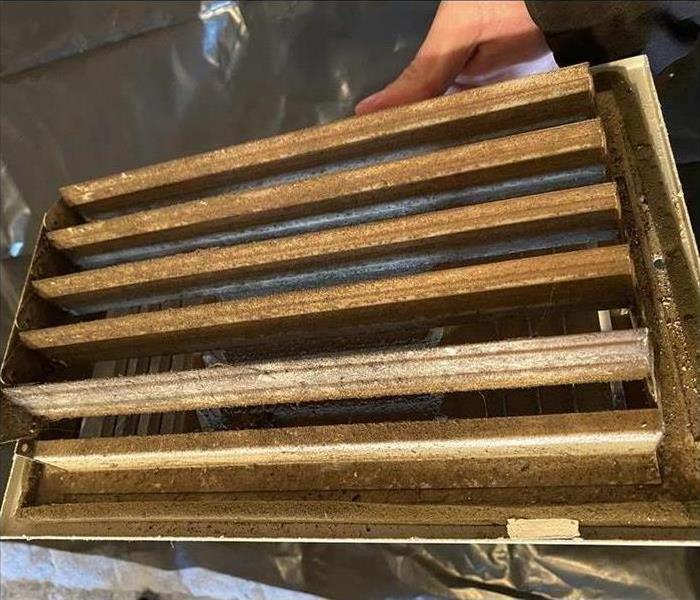 Dirty air vents can blow dust and debris into your home and create respiratory issues.
Dirty air vents can blow dust and debris into your home and create respiratory issues.
This time of year, it may feel that your nose is running more than normal. If so, it may be time to get your air ducts cleaned. During the spring, hay fever is more prevalent and with the unpredictable Texas weather, your HVAC system may be working overtime. In order to lengthen the lifespan of your HVAC system and keep your allergy symptoms to a minimum, air duct cleaning may be needed. Regular air duct cleaning removes dust, allergens, and potential mold spores that can hide in your ductwork throughout major temperature shifts. Experts suggest duct cleaning to be performed every three to five years, however, that are factors that could create the need for more frequent cleaning:
- Having pets in your home
- More frequent allergy flare-ups
- A noticed increase in health effects
- A build-up of dust on surfaces throughout the home, including inside the ducting system, on air vents, and on walls and ceilings near air vents.
If you feel your home may need duct cleaning, contact us for a free quote!
Things You Should Know In Case of Water Damage
10/5/2021 (Permalink)
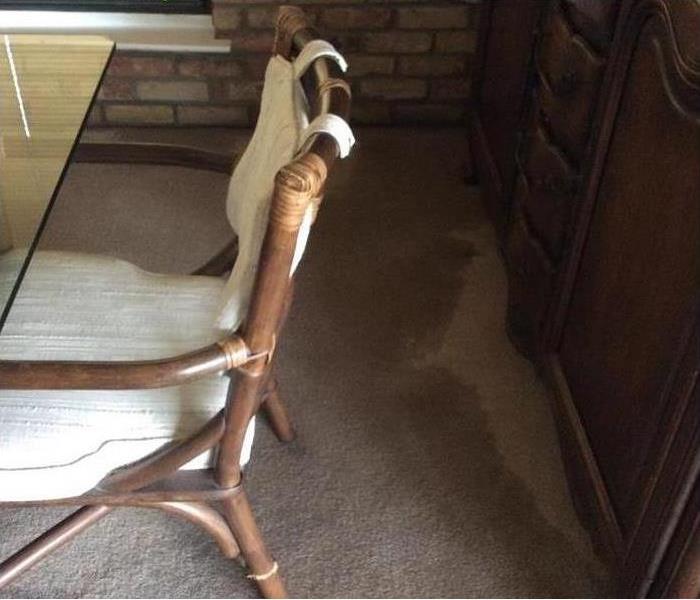 On carpet, water lines can be easily seen as the water can discolor the carpet and create staining.
On carpet, water lines can be easily seen as the water can discolor the carpet and create staining.
The sooner a leak from a water supply line is found, the better when dealing with water damage. This family had a leak from an upstairs bathroom water supply line that also infiltrated the entire downstairs.
Some facts about water damage that you may not know:
- Mold can start growing incredibly quickly (in as little as 24 hours), so call SERVPRO ASAP once you have experienced water damage.
- The smallest leak from a crack in a pipe can spill 250 gallons of water a day. This could lead to both higher utility bills and larger repair bills.
- If you are experiencing some sort of leak that is leading to water damage, turn off electricity in the affected area(s). Water is a conductor of electricity, which could be incredibly dangerous until water is extracted.
- If water has been sitting for more than 72 hours, it is considered “black water”. Black water is a pathogenic biohazard that can include sewage and chemical waste. This is the reason time is of the essence when remediating water damage.
Stop Further Water Damage with These Tips
9/30/2021 (Permalink)
If you find yourself experiencing a water loss in your home, follow along for some tips on how to prevent further damage to your home and furniture. If you are able, shut off the source of the water. Sometimes storms can bring water into your home, but if you have a leak inside your home, turn the water supply to your house off first. This will prevent any more leaking in your home until you can call the experts in to assess the damage and come up with a plan of action for remediation. If you have light flooding or a small water loss, protect your wooden furniture from rising water by wrapping the legs with aluminum foil or placing wood blocks under the wooden legs.
Do not use your household vacuum to remove water
Don’t turn on ceiling fixtures if the ceiling is wet.
Don’t leave wet fabrics up. Hang furs and leather goods.
Turn air conditioning on for maximum drying in the summer.
Remove colored rugs from wet carpeting to prevent staining.
Move art objects to a safe, dry place.
If you have light flooding or a small water loss, protect your wooden furniture from rising water by wrapping the legs with aluminum foil or placing wood blocks under the wooden legs.
This knowledge can help save you from an even bigger headache during your water damage, so don't forget to bookmark this page to refer back to in case of emergency, and call the pros at 940-241-3434.
HVAC Condensation Can Cause Water Damage
8/7/2019 (Permalink)
When your HVAC creates condensation, that water needs somewhere to spread, and those lines can become clogged quickly. This can cause your emergency line to either break or your drop pan to overfill! So, what should you do if this happens causing water damage?
Call an HVAC company to service your unit? This is probably the easiest and most efficient method, but unfortunately the most expensive.
Check to make sure your primary condensation line, usually located near the ground outside the home in an area of high foot traffic, is slowly dripping water when your HVAC is on.
If your primary line is not dripping check the secondary line, usually located somewhere like above a window or door as to be more noticeable when dripping.
If the primary, or both lines, are not dripping while the unit is on, find a way to flush out or remove the potential blockage. The cleanout will usually be located close to the HVAC main unit. Make sure you thoroughly research how to properly clear your lines before attempting to!
Check your HVAC unit drip pan, make sure it has no holes or rust around it. If it is damaged, you may need to have it replaced.
SERVPRO of Highland Village will come out and perform a free moisture inspection on your residence or commercial property if you believe you may have had a potential accident. We get an estimate to you or begin communication with your insurance. If you HVAC leaking, call SERVPRO of Highland Village at (940)-999-1279
Water trapped in a crawl space
6/14/2019 (Permalink)
Water from a storm not so long ago recently made its way underneath the home of a customer in Little Elm. SERVPRO of Highland Village was called to inspect the property for major holes in the foundation, as well as clean up the water and remove odors caused by the standing water under the house.
We successfully pumped all of the water out from underneath the house as well as dried the space out over a number of days. As the job was nearing an end, we then sprayed the space with one of our fresh SERVPRO deodorizers, as well as eliminated odors that were in the house due to the water.
The customer was very satisfied with our work upon completion and told us that she would certainly recommend us to anyone that she knew.





 24/7 Emergency Service
24/7 Emergency Service


